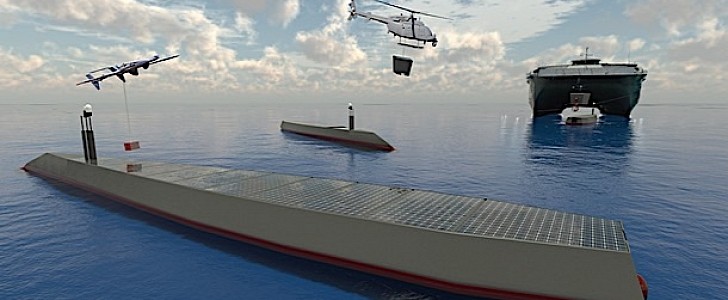Ever since humans started making tools for themselves, they constructed them with a single goal in mind: to serve their needs. And for a very long part of our history, that also meant having built machines that could accommodate us physically.
Since the advent of drones, that has changed. It’s not that long since humans learned they could do things remotely, but we’ve already come a great way in this respect. So now, in our day and age, machines that could not have operated unless under the direct control of a human beings are not only doing it, but have been designed to never be able to accommodate us mammals on board.
That’s mostly true for military aerial drones, and there’s more than one example of that in our skies. The maritime world, on the other hand, seems to fall behind in this respect, and DARPA plans to change that.
NOMARS is how their latest project in this field is called. The acronym stands for No Manning Required Ship and, as per the official description, it should be designed with no consideration whatsoever for crew, but with the utmost respect for payload, weight and power.
At the beginning of March, American defense contractor L3Harris announced it had been selected by DARPA for the Phase I of the NOMARS program, together with partner VARD Marine.
The company did not provide any details on the project it is working on, safe for the fact that its ship will be capable of making its own decisions and act upon them, without human intervention if need be.
“L3Harris continues to pioneer innovative autonomous solutions that offer fully automated and integrated ship control and preventative maintenance systems to the U.S. Navy and its allies,” said in a statement Sean Stackley, President, Integrated Mission Systems, L3Harris.
“The NOMARS program selection reinforces our commitment to deliver highly reliable and affordable autonomous solutions that transform the way the U.S. Navy conducts its future missions.”
That’s mostly true for military aerial drones, and there’s more than one example of that in our skies. The maritime world, on the other hand, seems to fall behind in this respect, and DARPA plans to change that.
NOMARS is how their latest project in this field is called. The acronym stands for No Manning Required Ship and, as per the official description, it should be designed with no consideration whatsoever for crew, but with the utmost respect for payload, weight and power.
At the beginning of March, American defense contractor L3Harris announced it had been selected by DARPA for the Phase I of the NOMARS program, together with partner VARD Marine.
The company did not provide any details on the project it is working on, safe for the fact that its ship will be capable of making its own decisions and act upon them, without human intervention if need be.
“L3Harris continues to pioneer innovative autonomous solutions that offer fully automated and integrated ship control and preventative maintenance systems to the U.S. Navy and its allies,” said in a statement Sean Stackley, President, Integrated Mission Systems, L3Harris.
“The NOMARS program selection reinforces our commitment to deliver highly reliable and affordable autonomous solutions that transform the way the U.S. Navy conducts its future missions.”

